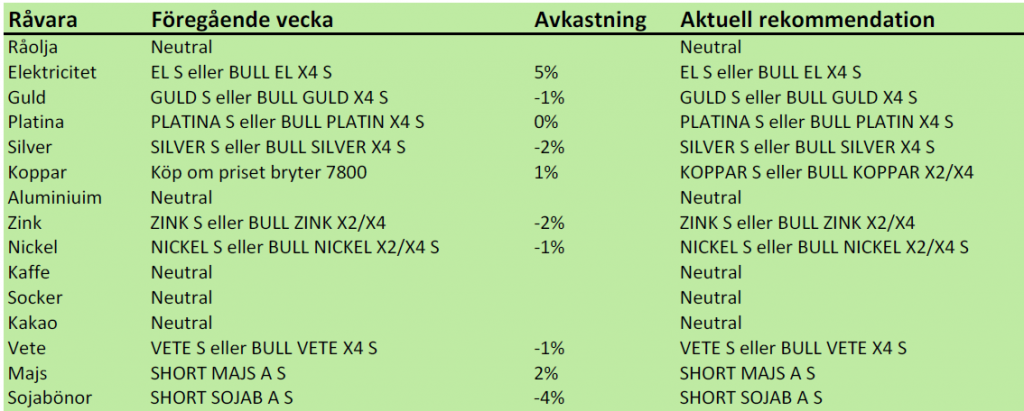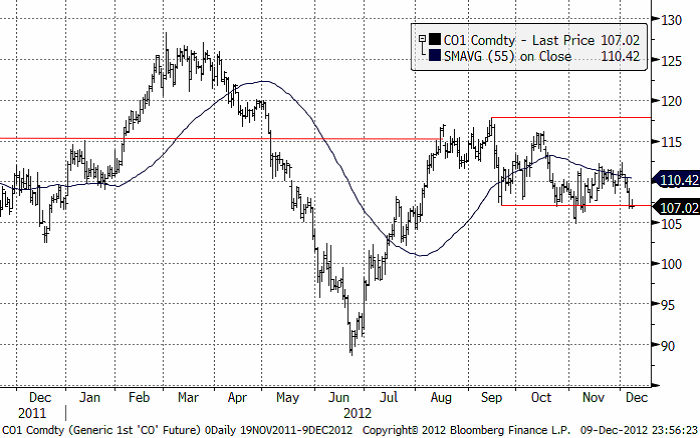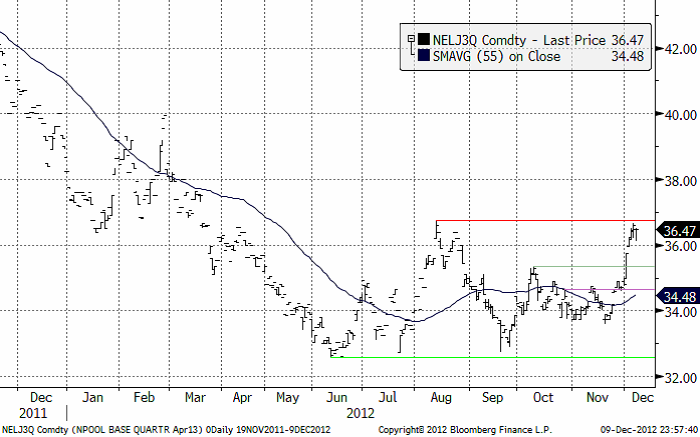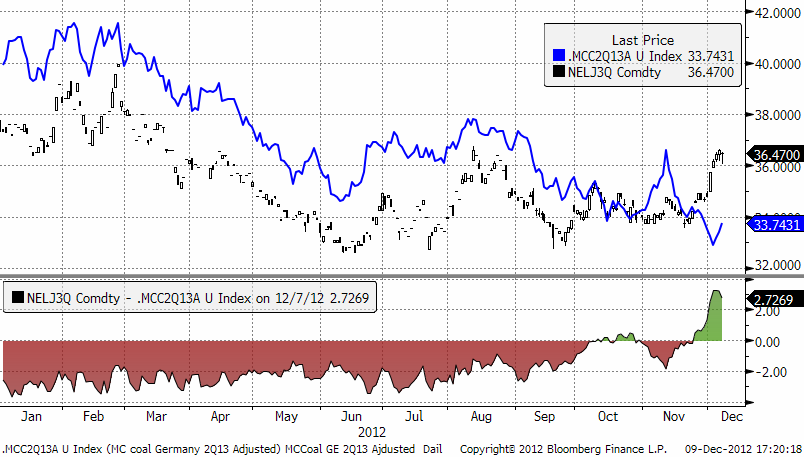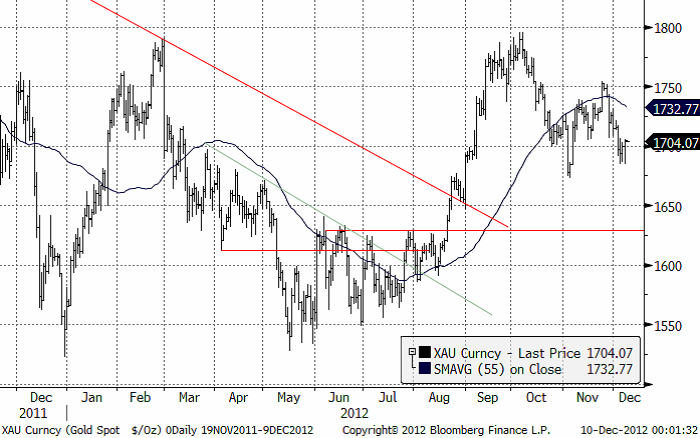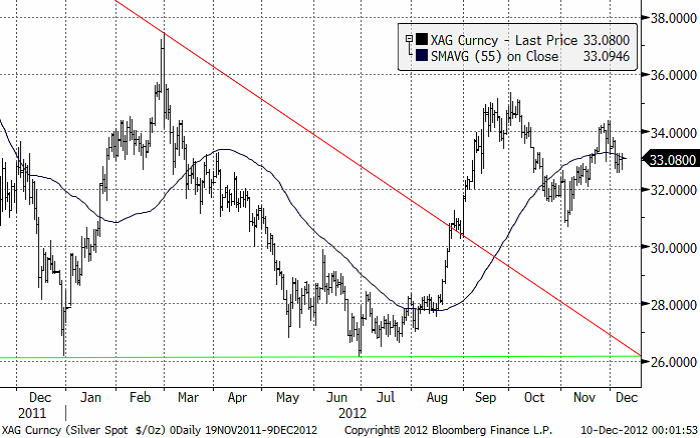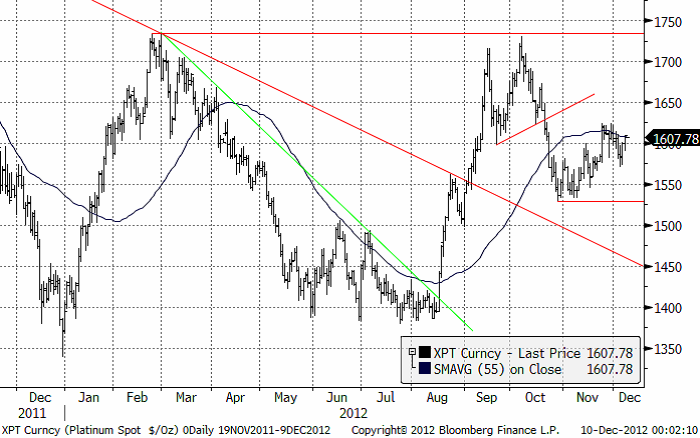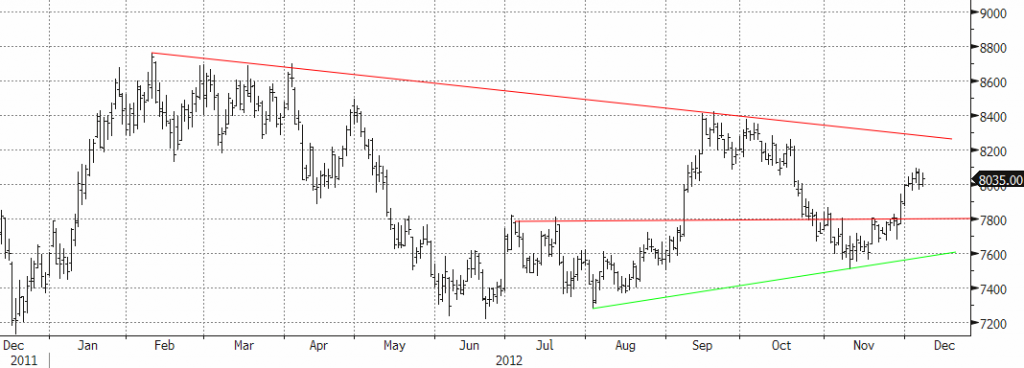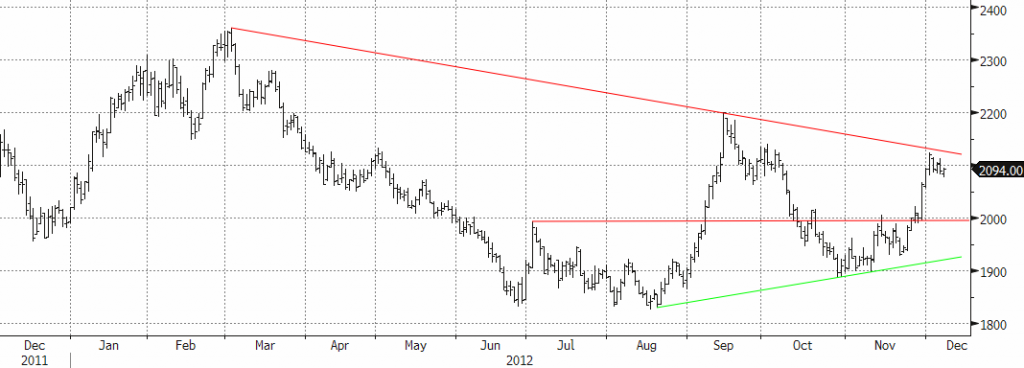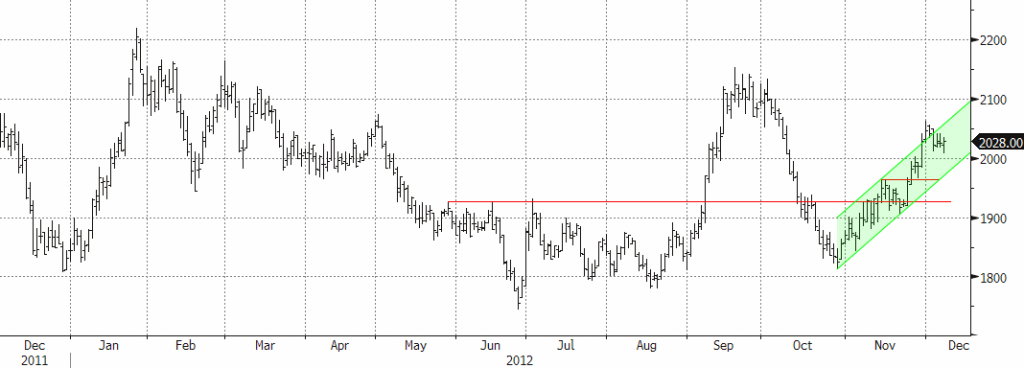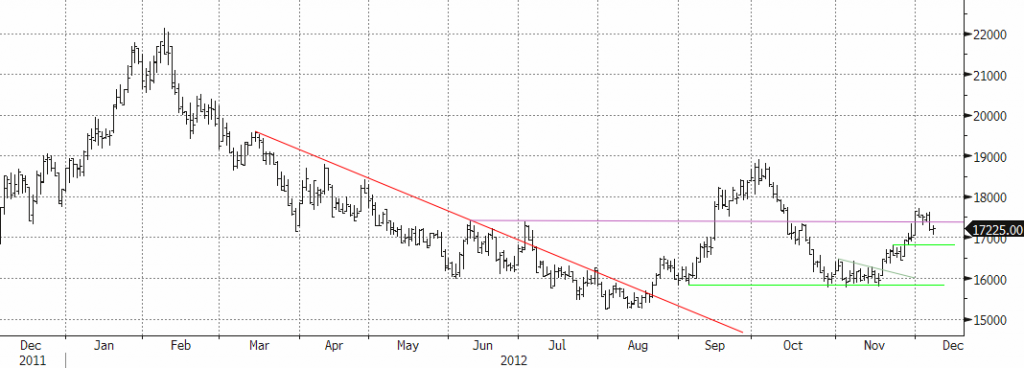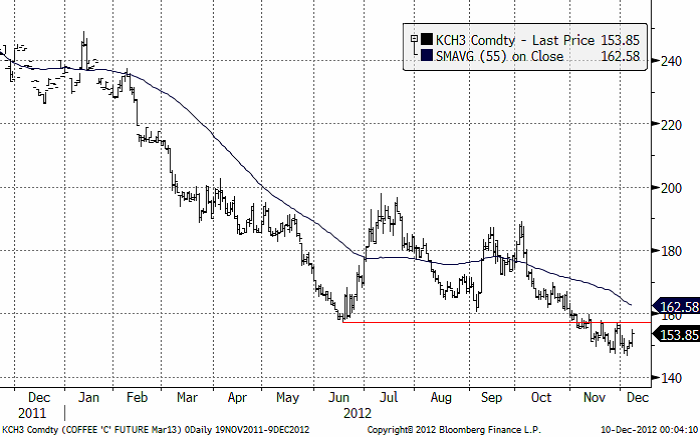Analys
SEB – Råvarukommentarer, 10 december 2012
Rekommendationer
Vi har nu köprekommendation på nästan alla basmetaller. Ädelmetallerna ser lite svagare ut. Råoljan ligger precis på ett stöd. Vi tar där bort rekommendationen att “köpa på “dips””, då utbuds- och efterfrågebalansen ytterligare försämrats något.
Sojabönor ser ut att ha rekylerat färdigt. Vi upprepar därför vår säljrekommendation på den. Position tar man lämpligen genom att köpa SHORT SOJAB A S, som har en hävstång på -1.38 gånger. Elpriset står strax under ett avgörande tekniskt motstånd. Vi fortsätter att rekommendera en köpt position. Notera att det nu är terminspriset för det andra kvartalet som utgör underliggande för certifikaten.
Råolja – Brent
I veckan som varit föll priset på Brent ca 3.5%. Olika orsaker bidrog, bl a svagare tillväxtutsikter för Europa, starkare usd, kraftigt ökande amerikanska oljeproduktlager och oro för Fiscal-Cliff.
Nedan ser vi spotkontraktets kursutveckling. Priset ligger precis på stödet 107 dollar. Nästa stöd finns på 105 dollar.
OPEC:s reservkapacitet beräknas öka signifikant under H1-2013 då svagare efterfrågan och ökande amerikansk oljeproduktion bidrar till att förbättra marknadsbalansen. OPEC produktionen är hög, ca 31.6 mfat/dag, den högsta nivån sedan 2008. Tecken finns nu på att man reducerar produktionen. Tanker-tracker Oil Movements rapporterar bl a om reducerad utskeppning av olja från OPEC länder. Vi förväntar oss att OPEC kommer justera ned oljeproduktionen när vi efter vintern går in i svagare säsongmässig efterfrågan.
På onsdag den 12 december är det OPEC möte. En oförändrad produktionskvot på 30 mfat förväntas kommuniceras. I nuläget produceras mer och i realiteten är det sannolikt Saudiarabien som måste minska sin produktion om man på allvar vill nå till kvotmålet. Societe Generale har i veckan kommunicerat att OPEC måste minska utbudet för att undvika ett 20 procentigt prisfall under H1-2013. Vid nuvarande pris är Saudierna nöjda, priset är där man kommunicerat att man vill det ska vara. Samtidigt är man orolig för vad ökande utbud och svagare efterfrågan kan komma att innebära. Man önskar stabilitet och lagom högt pris och landet måste sannolikt stå beredd att kraftigt strypa utbudet i fall ett större prisfall realiseras.
Den amerikanska oljeproduktionen förväntas öka ytterligare nästa år. Det senaste året har amerikansk produktion ökat med ca 1 mfat per dag.
Förra veckans DOE oljelager statistik visade att råoljelagren minskade med 2.4 mfat. Den stora överraskningen, vilket ledde till fallande råoljepris, var på produktsidan. Distillates ökade med 3.0 mfat medan bensinlagren ökade med hela 7.9 mfat.
I veckan har det alltså mest handlat om faktorer som pressar priset på olja. Samtidigt kvarstår den geopolitiska risken, speciellt som en nu en lite större del av riskpremien, efter prisfallet, försvunnit. Mellandestillaten, speciellt i Europa, utgör också en stödjande faktor för Brent, som lämpar sig väl för produktion av mellandestillat. I Europa är det också fortsatt stort fokus på den ansträngda lagersituationen för just mellandestillat. Vintern förstärker problemet, då efterfrågan på olja för uppvärmning på kontinenten säsongsmässigt ökar. Den hittills milda hösten och högt pris på mellandestillat har, så långt, dämpat efterfrågan men brukar bidra till att lyfta Brentkontraktet så här års.
I fredags stängde Brentkontraktet på 107.20 usd/fat. Kring nuvarande nivå håller vi en neutral vy. Då nedsiderisken ökat
Elektricitet
Underliggande terminskontrakt för SEB:s BULL, BEAR och linjära EL S-certfikat är nu terminskontraktet för det andra kvartalets genomsnittliga spotpris på NordPool. Vi ser kursdiagrammet för det terminskontraktet nedan. Som vi ser har uppgången från slutet av november gått genom två motståndsnivåer, och hejdas nu av det motstånd som ligger vid det övre intervallet, på 36.75 euro per MWh. Skulle detta brytas, kan vi konstatera att de senaste månadernas ”sidledes” rörelse eller ”konsolidering” är över och vi har en ny uppåtgående trend på elpriset.
Det kalla vädret ser i skrivande stund ut att fortsätta. Förra veckan har den hydrologiska balansen urholkats, överskottet är nu ca 7 TWh, från att en vecka tidigare varit 12 TWh. Kring årsskiftet kommer den med nuvarande prognoser ligga på normalen. Det visar hur snabbt systemet kan gå från relativt stort överskott till underskott och vice versa. Under lång tid har det varit ett stort hydrologiskt överskott. Normaliseras, eller skapas ett underskott, så finns ytterligare uppsida.
För en riktigt övertygande och varaktig uppgång krävs att marginalkostnaden för fossileldad kraftproduktion stiger. Prisuppgången på nordiska elmarknaden har under veckan mest varit väderstyrd, marginalkostnaden föll inledningsvis men steg i slutet av veckan, se graf. I fredags stärktes CO2 priset relativt kraftigt som en reaktion/tolkning på den pågående klimatkonferensen i Doha, dollarn förstärktes också. Kanske kan vi också förvänta oss draghjälp av kolet efter de senaste positiva tongångarna från Kina.
Nedan ser vi elpriset (som candle-stick-diagram) och marginalkostnaden för att producera el med kol under det andra kvartalet, baserat på terminspriser för kol och utsläppsrätter. Vi ser att den största delen av 2012 har terminspriset legat under marginalkostnaden för kolkraft i Tyskland.
Spotpriset reagerade som väntat på det kalla vädret, veckans högsta notering blev 58.51 EUR/MWh men har sedan successivt fallit tillbaka i takt med mildare temperaturer. Snittpriset för veckan blev 48.39 EUR/MWh, den högsta veckonoteringen sedan februari.
Vi har under ett antal veckors tid rekommenderat en long position i SEB:s certifikat på el. Förra veckan rullades den underliggande positionen från Q1-13 till Q2-13 terminen. Positionen har utvecklats väl under veckan och förutom stigande terminspriser, så har värdet utvecklats positivt tack vare den genomförda terminsrullningen. Bull El X2 steg i veckan med 9.42%.
Vi håller fast vid vår köpta position. Håller väderprognoserna i sig, så finns god chans för ytterligare lyft, speciellt om marginalkostnaden samtidigt stärks.
SEB har följande börshandlade certifikat kopplade till elterminer på Nasdaq OMX.
Long ———— Short
EL S ———— Bear El X2 S
Bull El X2 S — Bear El X4 S
Bull El X4 S
Guld och Silver
Guld- och silver har inte utvecklat sig så starkt som vi hade hoppats. Nu har dock båda rekylerat ner och kanske hittat botten på den kortsiktiga rekylen. Vi fortsätter att rekommendera en köpt position. ”Quantitative Easing” som genomförs i USA, Japan och Europa bör leda till att ädelmetaller stiger i pris i nominella termer.
Nedan ser vi kursdiagrammet för silver i dollar per troy ounce. Situationen är identisk med den för guld.
Platina
Platinapriset har klarat rekylen bättre än guld och silver. Platina har varit och är fortfarande vår favorit bland ädelmetallerna.
Basmetaller
Efter förra veckans kraftiga prisuppgång har priserna konsoliderat. Fortsatt starka indikationer från Kina och USA motverkas av Europa. Undantaget bland USA:s positiva indikatorer, var veckans ISM som svårförklarligt kom in under 50. Mer upplyftande var bygginvesteringar och bilförsäljningen (den starkaste i november på fem år). Veckan avslutades med en arbetsmarknadssiffra som kom in över förväntan. Det skapades 146 000 nya jobb utanför jordbrukssektorn mot väntade 85 000. Torsdagens räntebesked i Europa kom in oförändrat som väntat, men Draghis kommentarer skapade en del turbulens. Ekonomin är så pass svag att det kan bli tal om räntesänkningar. Euron föll kraftigt och så gjorde metaller och olja. Efter fredagens amerikanska siffra återhämtade sig priserna. Det mer positiva stämningsläget kring Kinas ekonomi visas bl.a. i det nedpressade aktieindexet som nu i december vänt upp med 5 %. En annan indikator värd att följa är terminskontraktet på armeringsjärn (rebar) på Shanghai Futures Exchange, som precis som aktiemarknaden varit rejält nedpressad under hösten, vilket är upp ca 4 % i december.
Sett över hela veckan noteras en marginell uppgång för koppar (som faktiskt släpat efter övriga basmetaller den här månaden), aluminium är oförändrad, medan förra veckans vinnare; nickel och zink rekylerar tillbaka ca 1,5 %.
Koppar
Priset konsoliderade mellan $8000 och $8100 under veckan. Det står och väger med det starka stödet vid $7800 (ett första psykologiskt stöd vid den jämna $8000-nivån), och motstånd vid strax över $8200. Koppar har släpat efter övriga basmetaller sedan vändningen uppåt i förra månaden. Koppar har kroniskt varit i en underskottssituation de senaste åren. Det är framför allt Chile som hela tiden visat lägre halter och produktionsproblem. Många prognoser tyder nu på att produktionen kommer att öka tillräckligt för att skapa en marknad i balans eller till och med ett visst överskott. Det har pratats mycket om det och är enligt vår mening till stor del redan diskonterat i dagens priser. Med rådande förväntningar på den nya regimen i Kina och sannolika infrastrukturprojekt, framför allt kopplade till elförsörjning, bedömer vi risken större på uppsidan. Som sagt priset står och väger, besvikelser över några konjunkturdata kan mycket väl innebära en rekyl nedåt. Kommer priset ner mot $7800 är koppar klart köpvärd.
Aluminium
Lagersituationen för aluminium har diskuterats i tidigare marknadsbrev. En stor del av överskottet ligger uppknutet i börstransaktioner, där finansiella aktörer utnyttjat den höga terminspremien, och ”låser upp” material under längre perioder. Detta i kombination med kapacitetsproblem i LME:s börslager, har skapt en tightare fysisk marknad än vad som annars skulle ha varit fallet. Detta speglas nu i stark efterfrågan för spotmaterial. Terminskurvan har gått över i s.k. backwardation, d.v.s. spotpriset är högre än terminspriset. Kortheten är koncentrerad perioden dec/jan.
Priset konsoliderade under veckan. Pristoppen i veckan kan vara den punkt som skapar en mer relevant motståndlinje (se chart) framöver att hålla ögonen på. Som vi sagt tidigare riskerar det stora LME-lagret att verka hämmande på priset. Vi kan mycket väl se en tillbakagång i veckan. $2000 är en bra stödnivå och en lämplig nivå för den som vill komma in i marknaden.
Zink
Som vi skrev i förra veckan är de största användningsområdena för zink är bygg- och transportindustrin. Två områden som nu gynnas av en mer positivt syn på tillväxten i Kina och USA. Zink ligger väl placerad i det scenariot. De kommande årens begränsningar av utbudet talar också för en starkare zinkmarknad. Hotet är, som vi också nämnt tidigare, kortsiktigt överskott p.g.a. ökad gruvproduktion i Kina. Enligt bedömare avtar tillväxten nu av det kinesiska utbudet. Zinkpriset är fortfarande lågt ur ett produktionskostnadsperspektiv. Överskottet har också byggt stora lager som måste betas av. Ett troligt scenario är samma utveckling som för aluminium, d.v.s. att lagret knyts upp i finansieringsupplägg (se tidigare beskrivningar kring aluminiummarknaden) som kommer att undanhålla material från konsumenter, vilket framför allt gynnar de fysiska premierna, men också sannolikt zinkpriset. Omsvängningen av stämningsläget gör att vi nu bedömer att marknaden kommer diskontera starkare fundamental balans, vilket ofta innebär att investerare köper i ”förtid”.
Priset orkade inte hålla nivåerna utanför trendkanalen, utan följde med övriga metaller i veckans konsolideringsfas. Om vi ser en fortsatt försvagning under veckans inledning kan vi få bra köptillfällen kring och strax under $2000.
Vi rekommenderar köp av ZINK S eller BULL ZINK X2 / X4 S för den som vill ta mer risk. Man bör gå ur positionen om priset faller genom 1930 dollar per ton, som är stödet i den konsolideringsfas som varit rådande sedan prisfallet slutade i slutet av maj. Kortsiktigt bör man ta hem vinst vid moståndsnivån $2150. På lite längre sikt är potentialen större. Nästa motståndsnivå kommer in vid $2200, men målet är $2500.
Nickel
Nickel var något av en besvikelse i veckan, och tog enligt vår uppfattning oförtjänt mycket stryk i torsdags i samband med Eurons försvagning (efter Draghis prat om räntesänkning). Men det är lite ”som vanligt” att nickel reagerar kraftigare än övriga metaller. Den är mer volatil. En förklaring till nedgången kan vara marknadens oro för att Kina ska öka produktionen nu med högre priser. Det har tidigare visat sig, att framför allt produktionen av s.k. Nickel Pig Iron, går att ställa om ganska snabbt. Än så länge noteras inga sådana indikationer. Ett annat orosmoln är den nya teknikens (urlakningsmetoder) projekt som är på gång nästa år. Det skapar osäkerhet. De senaste åren har dessa projekt inte levt upp till förväntningarna. Kommer det inte ut mer material så kan det bli tight på nickel, och i ett mer positivt konjunkturscenario kan det innebär mycket högre priser.
Vi har tidigare haft $17500 som någon form av målkurs i den här uppgången. Motståndet har visat sig vara signifikant. Det finns risk för ytterligare tillbakagång. Men som vi skrev i förra veckan kommer nästa stöd in redan strax under $17000.
Vi rekommenderar köp av NICKEL S eller BULL NICKEL X2 / X4 S för den som vill ta mer risk. Man bör gå ur positionen om priset faller genom 15,800 dollar per ton, som är stödet i den konsolideringsfas som varit rådande sedan prisfallet slutade i slutet av oktober. Kortsiktigt bör man ta hem vinst vid moståndsnivån $17500. På lite längre sikt är potentialen större. Nästa motståndsnivå kommer in strax under $19000
Kaffe
Kaffepriset (mars 2013) ligger alltjämt under den viktiga motståndsnivån på strax under 160 cent per pund. Ett par test av nivån, att bryta uppåt, har gjorts och fredagens uppgång ser ut att bli det tredje försöket. Ett brott uppåt ska ses som ett tecken på att den fallande trenden har blivit försvagad. Test av motståndsnivåer är också ett tillfälle att sälja.
Se SEB Jordbruksprodukter från tidigare idag för analyser av fler jordbruksråvaror.
[box]SEB Veckobrev Veckans råvarukommentar är producerat av SEB Merchant Banking och publiceras i samarbete och med tillstånd på Råvarumarknaden.se[/box]
Disclaimer
The information in this document has been compiled by SEB Merchant Banking, a division within Skandinaviska Enskilda Banken AB (publ) (“SEB”).
Opinions contained in this report represent the bank’s present opinion only and are subject to change without notice. All information contained in this report has been compiled in good faith from sources believed to be reliable. However, no representation or warranty, expressed or implied, is made with respect to the completeness or accuracy of its contents and the information is not to be relied upon as authoritative. Anyone considering taking actions based upon the content of this document is urged to base his or her investment decisions upon such investigations as he or she deems necessary. This document is being provided as information only, and no specific actions are being solicited as a result of it; to the extent permitted by law, no liability whatsoever is accepted for any direct or consequential loss arising from use of this document or its contents.
About SEB
SEB is a public company incorporated in Stockholm, Sweden, with limited liability. It is a participant at major Nordic and other European Regulated Markets and Multilateral Trading Facilities (as well as some non-European equivalent markets) for trading in financial instruments, such as markets operated by NASDAQ OMX, NYSE Euronext, London Stock Exchange, Deutsche Börse, Swiss Exchanges, Turquoise and Chi-X. SEB is authorized and regulated by Finansinspektionen in Sweden; it is authorized and subject to limited regulation by the Financial Services Authority for the conduct of designated investment business in the UK, and is subject to the provisions of relevant regulators in all other jurisdictions where SEB conducts operations. SEB Merchant Banking. All rights reserved.
Analys
Tightening fundamentals – bullish inventories from DOE

The latest weekly report from the US DOE showed a substantial drawdown across key petroleum categories, adding more upside potential to the fundamental picture.

Commercial crude inventories (excl. SPR) fell by 5.8 million barrels, bringing total inventories down to 415.1 million barrels. Now sitting 11% below the five-year seasonal norm and placed in the lowest 2015-2022 range (see picture below).
Product inventories also tightened further last week. Gasoline inventories declined by 2.1 million barrels, with reductions seen in both finished gasoline and blending components. Current gasoline levels are about 3% below the five-year average for this time of year.
Among products, the most notable move came in diesel, where inventories dropped by almost 4.1 million barrels, deepening the deficit to around 20% below seasonal norms – continuing to underscore the persistent supply tightness in diesel markets.
The only area of inventory growth was in propane/propylene, which posted a significant 5.1-million-barrel build and now stands 9% above the five-year average.
Total commercial petroleum inventories (crude plus refined products) declined by 4.2 million barrels on the week, reinforcing the overall tightening of US crude and products.


Analys
Bombs to ”ceasefire” in hours – Brent below $70

A classic case of “buy the rumor, sell the news” played out in oil markets, as Brent crude has dropped sharply – down nearly USD 10 per barrel since yesterday evening – following Iran’s retaliatory strike on a U.S. air base in Qatar. The immediate reaction was: “That was it?” The strike followed a carefully calibrated, non-escalatory playbook, avoiding direct threats to energy infrastructure or disruption of shipping through the Strait of Hormuz – thus calming worst-case fears.

After Monday morning’s sharp spike to USD 81.4 per barrel, triggered by the U.S. bombing of Iranian nuclear facilities, oil prices drifted sideways in anticipation of a potential Iranian response. That response came with advance warning and caused limited physical damage. Early this morning, both the U.S. President and Iranian state media announced a ceasefire, effectively placing a lid on the immediate conflict risk – at least for now.
As a result, Brent crude has now fallen by a total of USD 12 from Monday’s peak, currently trading around USD 69 per barrel.
Looking beyond geopolitics, the market will now shift its focus to the upcoming OPEC+ meeting in early July. Saudi Arabia’s decision to increase output earlier this year – despite falling prices – has drawn renewed attention considering recent developments. Some suggest this was a response to U.S. pressure to offset potential Iranian supply losses.
However, consensus is that the move was driven more by internal OPEC+ dynamics. After years of curbing production to support prices, Riyadh had grown frustrated with quota-busting by several members (notably Kazakhstan). With Saudi Arabia cutting up to 2 million barrels per day – roughly 2% of global supply – returns were diminishing, and the risk of losing market share was rising. The production increase is widely seen as an effort to reassert leadership and restore discipline within the group.
That said, the FT recently stated that, the Saudis remain wary of past missteps. In 2018, Riyadh ramped up output at Trump’s request ahead of Iran sanctions, only to see prices collapse when the U.S. granted broad waivers – triggering oversupply. Officials have reportedly made it clear they don’t intend to repeat that mistake.
The recent visit by President Trump to Saudi Arabia, which included agreements on AI, defense, and nuclear cooperation, suggests a broader strategic alignment. This has fueled speculation about a quiet “pump-for-politics” deal behind recent production moves.
Looking ahead, oil prices have now retraced the entire rally sparked by the June 13 Israel–Iran escalation. This retreat provides more political and policy space for both the U.S. and Saudi Arabia. Specifically, it makes it easier for Riyadh to scale back its three recent production hikes of 411,000 barrels each, potentially returning to more moderate increases of 137,000 barrels for August and September.
In short: with no major loss of Iranian supply to the market, OPEC+ – led by Saudi Arabia – no longer needs to compensate for a disruption that hasn’t materialized, especially not to please the U.S. at the cost of its own market strategy. As the Saudis themselves have signaled, they are unlikely to repeat previous mistakes.
Conclusion: With Brent now in the high USD 60s, buying oil looks fundamentally justified. The geopolitical premium has deflated, but tensions between Israel and Iran remain unresolved – and the risk of missteps and renewed escalation still lingers. In fact, even this morning, reports have emerged of renewed missile fire despite the declared “truce.” The path forward may be calmer – but it is far from stable.
Analys
A muted price reaction. Market looks relaxed, but it is still on edge waiting for what Iran will do

Brent crossed the 80-line this morning but quickly fell back assigning limited probability for Iran choosing to close the Strait of Hormuz. Brent traded in a range of USD 70.56 – 79.04/b last week as the market fluctuated between ”Iran wants a deal” and ”US is about to attack Iran”. At the end of the week though, Donald Trump managed to convince markets (and probably also Iran) that he would make a decision within two weeks. I.e. no imminent attack. Previously when when he has talked about ”making a decision within two weeks” he has often ended up doing nothing in the end. The oil market relaxed as a result and the week ended at USD 77.01/b which is just USD 6/b above the year to date average of USD 71/b.

Brent jumped to USD 81.4/b this morning, the highest since mid-January, but then quickly fell back to a current price of USD 78.2/b which is only up 1.5% versus the close on Friday. As such the market is pricing a fairly low probability that Iran will actually close the Strait of Hormuz. Probably because it will hurt Iranian oil exports as well as the global oil market.
It was however all smoke and mirrors. Deception. The US attacked Iran on Saturday. The attack involved 125 warplanes, submarines and surface warships and 14 bunker buster bombs were dropped on Iranian nuclear sites including Fordow, Natanz and Isfahan. In response the Iranian Parliament voted in support of closing the Strait of Hormuz where some 17 mb of crude and products is transported to the global market every day plus significant volumes of LNG. This is however merely an advise to the Supreme leader Ayatollah Ali Khamenei and the Supreme National Security Council which sits with the final and actual decision.
No supply of oil is lost yet. It is about the risk of Iran closing the Strait of Hormuz or not. So far not a single drop of oil supply has been lost to the global market. The price at the moment is all about the assessed risk of loss of supply. Will Iran choose to choke of the Strait of Hormuz or not? That is the big question. It would be painful for US consumers, for Donald Trump’s voter base, for the global economy but also for Iran and its population which relies on oil exports and income from selling oil out of that Strait as well. As such it is not a no-brainer choice for Iran to close the Strait for oil exports. And looking at the il price this morning it is clear that the oil market doesn’t assign a very high probability of it happening. It is however probably well within the capability of Iran to close the Strait off with rockets, mines, air-drones and possibly sea-drones. Just look at how Ukraine has been able to control and damage the Russian Black Sea fleet.
What to do about the highly enriched uranium which has gone missing? While the US and Israel can celebrate their destruction of Iranian nuclear facilities they are also scratching their heads over what to do with the lost Iranian nuclear material. Iran had 408 kg of highly enriched uranium (IAEA). Almost weapons grade. Enough for some 10 nuclear warheads. It seems to have been transported out of Fordow before the attack this weekend.
The market is still on edge. USD 80-something/b seems sensible while we wait. The oil market reaction to this weekend’s events is very muted so far. The market is still on edge awaiting what Iran will do. Because Iran will do something. But what and when? An oil price of 80-something seems like a sensible level until something do happen.
-

 Nyheter3 veckor sedan
Nyheter3 veckor sedanMahvie Minerals växlar spår – satsar fullt ut på guld
-

 Nyheter4 veckor sedan
Nyheter4 veckor sedanUppgången i oljepriset planade ut under helgen
-

 Nyheter4 veckor sedan
Nyheter4 veckor sedanLåga elpriser i sommar – men mellersta Sverige får en ökning
-

 Nyheter3 veckor sedan
Nyheter3 veckor sedanJonas Lindvall är tillbaka med ett nytt oljebolag, Perthro, som ska börsnoteras
-

 Analys3 veckor sedan
Analys3 veckor sedanA muted price reaction. Market looks relaxed, but it is still on edge waiting for what Iran will do
-

 Nyheter3 veckor sedan
Nyheter3 veckor sedanOljan, guldet och marknadens oroande tystnad
-

 Analys4 veckor sedan
Analys4 veckor sedanVery relaxed at USD 75/b. Risk barometer will likely fluctuate to higher levels with Brent into the 80ies or higher coming 2-3 weeks
-

 Nyheter3 veckor sedan
Nyheter3 veckor sedanDomstolen ger klartecken till Lappland Guldprospektering


